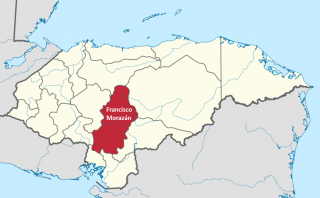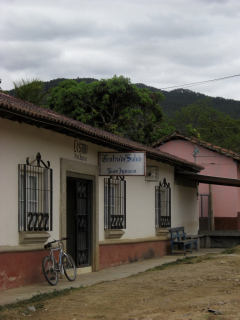San Ignacio, Honduras
![]()
![]()
![]()
![]()
![]()
![]()
![]()
![]()
![]() Click on Programs to learn more about their work in this community
Click on Programs to learn more about their work in this community
General Information

| Population* | 2722 |
| Number of homes | 650 |
| Avg # of people per home | 4.2 |
|
Number and % of children |
(0-5yrs): 317/11.6% (0-9yrs): 582/21.3% |
| Electricity | Yes |
| GPS |
N 14° 39.512’ W 087° 02.102’ |
| Municipality | San Ignacio |
| Department | Francisco Morazán |
| Corresponding Health Center | CESAMO-San Ignacio |
| Distance from compounds | 2 hours |
| Road conditions | Good |
* Population does not reflect how many patients will be seen on medical
brigades as many people from surrounding communities come seeking
Medical Brigades medical attention.
Top Needs Expressed
The top needs expressed by the key community members are latrines and potable water with good quality.
San Ignacio’s educational system includes Kinder and Primary schools until the 6th grade.
San Ignacio has a water system that only provides water every 8 days. The water is chlorinated, but only about every 20 days1 due to a lack of organization and leadership of the 8-member Water Council. About 90% of homes are connected to the system, though surrounding villages that participate in medical brigades in San Ignacio have far less access to clean water.
San Ignacio has a health center in the community that also offers  dental care. There is no community health committee.
dental care. There is no community health committee.
The most common illnesses seen by community members are common cold, intestinal parasites, and pharyngotonsillitis. Approximately 95% of the community is estimated to have latrines that currently function. 75-100% has eco-stoves (estufas justas) or better. A lot of people have electric stoves. About 90% is estimated to have cement floors.
Below are health statistics from CESAMO-San Ignacio2:
I. Annual Morbitities for People Under 5 Years, 2009: CESAMO-San Ignacio
|
Rank |
Morbidity |
Number of Cases (2009) |
|
1 |
Common Cold |
579 |
|
2 |
Diarrhea |
292 |
|
3 |
Intestinal Parasites |
127 |
|
4 |
Skin infections |
125 |
|
5 |
Conjunctivitis |
56 |
|
6 |
Pneumonia |
55 |
|
7 |
Pharyngotonsilitis |
52 |
|
8 |
Eye infection |
25 |
|
9 |
Urinary infection |
19 |
|
10 |
Skin allergies |
11 |
Centro de Salud Statistics, Centro de Salud-Francisco Morazán, 21 Marzo 2010
I. Annual Morbitities for People Over 5 Years, 2009: CESAMO-San Ignacio
|
Rank |
Morbidity |
Number of Cases (2009) |
|
1 |
Common Cold |
375 |
|
2 |
Intestinal Parasites |
245 |
|
3 |
Pharyngotonsilitis |
222 |
|
4 |
Urinary Tract Infection |
203 |
|
5 |
Acid Peptic Disorders |
138 |
|
6 |
Skin infections |
134 |
|
7 |
Dermatitis |
102 |
|
8 |
Fungal infection (micosis) |
71 |
|
9 |
Eye infection |
58 |
|
10 |
Sexually Transmitted Infection |
57 |
Centro de Salud Statistics, Centro de Salud-Francisco Morazán, 21 Marzo 2010
The average family income per month is estimated to be 1500 Lempiras, which is approximately L300 (US $15.88) per person3. The majority of homes are made of adobe. The main form of employment is agriculture on rented land. The main products that are cultivated in the community are corn, beans, plantain, and yuca. Until it closed about 3-4 years ago, there was a large gold mine where many people were employed. Members of San Ignacio have access to credit at cooperatives and BANADESA for agricultural loans. They used to run a community bank, but it is not fully functioning now.
San Ignacio has been receiving medical brigades with specialized care from Enma Callejas, most recently in 2009 with gynecology consults. Juan Alclaire provides support for kids with special needs. Fundación San Martín supported the mine until 3-4 years ago.
San Ignacio is a relatively large town with a gasoline station and large central parks. The health center serves 4 other communities that total about 3698 potential beneficiaries.
|
Education |
93rd |
|
Water |
19th |
|
Health |
94th |
|
Socio-economics |
39th |
|
Collaboration |
69th |
|
Overall |
93rd |
Total communities evaluated: 97
Source of information: Key informant interview, Centro de Salud statistics
Date of interview: 21 March 2010
1The accepted regulation frequency for chlorinating water is every 4 days.
2CESAMO and CESAR are terms used for types of health centers. CESAMOs are larger, more comprehensive facilities that usually have a physician on staff at all times and occasionally a dentist. CESARs are more remote, less equipped facilities, usually with 1-2 nurses on staff.
3According to Red Solidaria and World Food Programme in Honduras, the average family is approximated at 5 people per household, the poverty line is L930 (US$49.23) per person per month, and the extreme poverty line is L617 (US$32.66) per person per month.